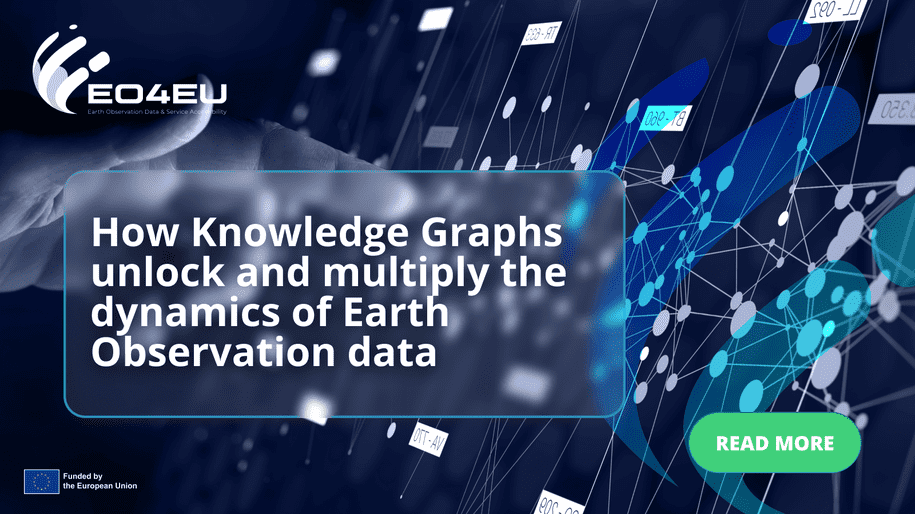How Knowledge Graphs unlock and multiply the dynamics of Earth Observation data
In the cataclysm of big data challenges, knowledge graphs have emerged as a powerful tool for organizing and representing complex information. These graph-structured data models, where nodes represent entities and edges represent relationships, are revolutionizing how we understand and utilize data across various domains, including earth observation. This article explores the significance of knowledge graphs in earth observation, highlighting their benefits, challenges, and practical applications.
The role of Knowledge Graphs
Knowledge graphs (KGs) integrate data from diverse sources, such as Wikipedia, web pages, and public datasets, into a cohesive framework. They employ schemas and ontologies to define the types of entities, attributes, and relationships within the graph, enabling efficient navigation and exploration of knowledge. This structured approach allows for rich semantic modelling, where entities are connected through various types of relationships, forming a web of interconnected knowledge.
KGs offer numerous benefits, including a unified view of disparate data sources, enhanced contextual information, improved data interoperability, and advanced analytics. They represent knowledge in a direct and expandable way, performing better in data-intensive environments. By adhering to standard semantic web technologies, KGs enhance data sharing and collaboration among organizations. However, KGs face several challenges. Integrating data from multiple sources can be complex and time-consuming due to diverse data formats, varying data quality, and conflicting representations. Performing efficient queries and traversals on large-scale KGs can be computationally intensive, requiring specialized indexing techniques and distributed processing frameworks. Additionally, KGs may suffer from incompleteness, resulting in gaps and limitations when performing complex reasoning or inference tasks. Continuous updates and maintenance are required to reflect the evolving knowledge landscape, ensuring data consistency and schema evolution. Resolving the semantic gap between natural language and structured knowledge remains a complex task, requiring advances in natural language processing and entity disambiguation.
Knowledge Graphs in Earth Observation
Earth observation involves the systematic collection and analysis of information about the earth and its environment using remote sensing technologies. KGs play a crucial role in integrating and analyzing this data, providing valuable insights for environmental management, disaster response, climate studies, and more.
Earth observation data comes from various sources, including satellites, aircraft, drones, and ground-based instruments. KGs provide a means to integrate these heterogeneous data sources, allowing for a comprehensive view of the earth system. By linking diverse datasets, KGs facilitate cross-domain analysis and enable the discovery of new relationships and insights.
KGs leverage semantic technologies and ontologies to harmonize and standardize data representation. This semantic interoperability ensures that data from different sources can be seamlessly integrated, queried, and analyzed, enabling effective collaboration and information sharing among researchers and stakeholders.
Moreover, KGs capture not only the data itself but also the context and metadata associated with earth observations. This includes information about spatial and temporal aspects, sensor characteristics, measurement units, and quality indicators. By representing such contextual information, KGs enhance the interpretability and reliability of the data, facilitating better decision-making and analysis.
Earth observations involve complex spatial and temporal relationships. KGs provide a natural representation of these relationships, allowing for the discovery of patterns, trends, and dependencies. Through reasoning and inference capabilities, KGs enable the identification of implicit information, the prediction of missing values, and the discovery of hidden patterns or correlations.
KGs offer a flexible and interactive framework for exploring and visualizing earth observation data. Graph visualization techniques help in understanding the complex network of relationships between different entities, aiding in the identification of clusters, outliers, and anomalies. This visual representation enhances data exploration, hypothesis generation, and communication of results to various stakeholders.
Practical Applications of KGs within the EO4EU Project
KGs have numerous practical applications in earth observation. They integrate diverse earth observation datasets to facilitate real-time tracking of environmental changes and support climate research. In agriculture, KGs enhance crop management and optimize resource allocation through precision farming strategies. Disaster management benefits from improved early warning systems and streamlined emergency response by providing timely access to relevant information. Biodiversity conservation is aided by species tracking and habitat preservation, while natural resource management relies on KGs for efficient resource allocation and monitoring. Urban planning is supported by tasks such as environmental monitoring, disaster response planning, and climate change impact assessment.
The EO4EU project aims to democratize access to earth observation data, catering to users with varying levels of technical expertise. The knowledge graph provides a user-friendly tool for discovering relevant datasets and resources, empowering non-expert users to leverage the abundance of available information. For seasoned practitioners, the knowledge graph serves as a valuable resource for identifying new or recently updated datasets that complement their existing knowledge. This dual functionality enhances accessibility and encourages collaboration among users with diverse levels of expertise, advancing the utilization of earth observation data across different domains and applications.
Contribution: Novelcore
